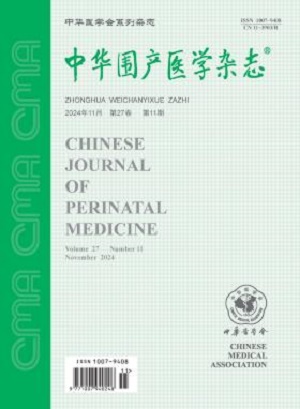Effects of neonatal intensive care unit-centered regional transport network on treatment of retinopathy of prematurity
Q4 Medicine
引用次数: 0
Abstract
Objective To investigate the effects of neonatal intensive care unit (NICU)-centered regional neonatal transport network (NTN) on the treatment of retinopathy of prematurity (ROP). Methods A retrospective analysis was conducted to analyze the transfer, treatment and outcomes of 406 preterm infants with ROP who were transferred to the Bayi Children's Hospital Affiliated to the Seventh Medical Center of PLA General Hospital via the NTN from July 2008 to December 2014. Independent sample t-test, Chi-square test and Mann-Whitney nonparametric test were used for statistical analysis. Results Among the 406 premature infants who were transferred to our hospital because of ROP, there were 257 males and 149 females with the gestational age of (29.5±1.9) weeks (24+5-36 weeks) and the birth weight of (1 234.8± 268.9) g (580-2 400 g). The age at transfer was (48.9±18.5) d (15-78 d) and the transport distance was (216.5±78.6) km (10-625 km). No death was reported during the transportation. Very preterm births and very low birth weight infants (VLBWI) accounted for 88.7% (360 cases) and 82.5% (335 cases), respectively. Lesions occurred in 1, 2 and 3 zones were detected in 98 (24.1%), 286 (70.4%) and 22 (5.4%) cases, respectively. Lesions of stage 1-5 were observed in 51 (12.6%), 156 (38.4%), 183 (45.1%), 12 (3.0%) and 4 (1.0%) cases. There were 186 cases (45.8%) with Plus lesions. A total of 252 cases (62.1%) underwent surgery which were achieving treatment standards, including 165 (65.5%) undergoing laser therapy, 93 (36.9%) receiving anti-vascular endothelial growth factor (VEGF) therapy, 16 (6.4%) having vitrectomy and two (0.8%) having scleral buckling. Eighteen infants were diagnosed with retinal structural abnormalities, among which 16 had retinal detachment before admission (12 in phase 4 and four in phase 5). Two without retinal detachment on admission developed to phase 4 after surgery. The incidence of retinal structural dysplasia was 0.9% (2/236) in infants receiving laser and/or anti-VEGF therapy in our hospital. Compared with the cured patients (n=234), those with retinal structural dysplasia (n=18) had a late transfer time [80 (38-270) vs 50 (19-150) d, Z=3.387, P<0.001]. Conclusions The NICU-centered and regional transfer-based ROP treatment network provides timely and effective treatment for infants with ROP. Key words: Retinopathy of prematurity; Intensive care units, neonatal; Patient handoff; Treatment outcome以新生儿重症监护室为中心的区域运输网络在早产儿视网膜病变治疗中的作用
目的探讨以新生儿重症监护室(NICU)为中心的区域新生儿转运网络(NTN)治疗早产儿视网膜病变(ROP)的效果。方法对2008年7月至2014年12月经NTN转运至解放军总医院第七医学中心附属八一儿童医院的406例ROP早产儿的转运、治疗及转归进行回顾性分析。采用独立样本t检验、卡方检验和Mann-Whitney非参数检验进行统计分析。结果因ROP转院的406例早产儿中,男257例,女149例,胎龄(29.5±1.9)周(24+5-36周),出生体重(1234.8±268.9)g(580-2400g)。转移年龄为(48.9±18.5)d(15-78 d),运输距离为(216.5±78.6)km(10-625 km)。运输过程中没有死亡报告。极早产和极低出生体重儿(VLBWI)分别占88.7%(360例)和82.5%(335例)。分别有98例(24.1%)、286例(70.4%)和22例(5.4%)在1、2和3个区域发现病变。1-5期病变有51例(12.6%)、156例(38.4%)、183例(45.1%)、12例(3.0%)和4例(1.0%)。Plus病变186例(45.8%)。共有252例(62.1%)接受了符合治疗标准的手术,其中165例(65.5%)接受了激光治疗,93例(36.9%)接受了抗血管内皮生长因子(VEGF)治疗,16例(6.4%)接受了玻璃体切除术,2例(0.8%)接受了巩膜扣带术。18名婴儿被诊断为视网膜结构异常,其中16名婴儿在入院前出现视网膜脱离(12名婴儿处于4期,4名婴儿处于5期)。两名患者入院时无视网膜脱离,术后发展为4期。在我院接受激光和/或抗VEGF治疗的婴儿中,视网膜结构发育不良的发生率为0.9%(2/236)。与治愈患者(n=234)相比,视网膜结构发育不良患者(n=18)的转移时间较晚[80(38-270)vs 50(19-150)d,Z=3.387,P<0.001]。关键词:早产儿视网膜病变;重症监护室,新生儿;患者交接;治疗结果
本文章由计算机程序翻译,如有差异,请以英文原文为准。
求助全文
约1分钟内获得全文
求助全文
来源期刊

中华围产医学杂志
Medicine-Obstetrics and Gynecology
CiteScore
0.70
自引率
0.00%
发文量
4446
期刊介绍:
Chinese Journal of Perinatal Medicine was founded in May 1998. It is one of the journals of the Chinese Medical Association, which is supervised by the China Association for Science and Technology, sponsored by the Chinese Medical Association, and hosted by Peking University First Hospital. Perinatal medicine is a new discipline jointly studied by obstetrics and neonatology. The purpose of this journal is to "prenatal and postnatal care, improve the quality of the newborn population, and ensure the safety and health of mothers and infants". It reflects the new theories, new technologies, and new progress in perinatal medicine in related disciplines such as basic, clinical and preventive medicine, genetics, and sociology. It aims to provide a window and platform for academic exchanges, information transmission, and understanding of the development trends of domestic and foreign perinatal medicine for the majority of perinatal medicine workers in my country.
 求助内容:
求助内容: 应助结果提醒方式:
应助结果提醒方式:


